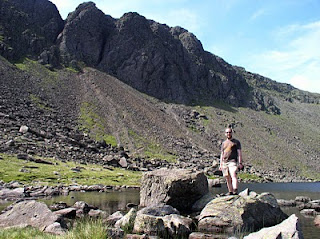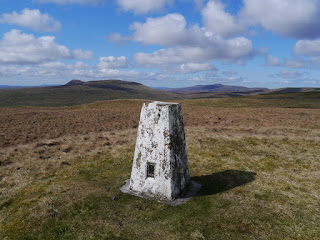I tried, as usual, to sample as many different areas as I
could. With eight walks this was by far my most productive year of walking in
the North York Moors and these walks in the Moors were some of the many
highlights of the year. On the flip side I only managed two walks in the North
Pennines and only three in the Peak District. With the latter this was partly
due to my dislike of the drive down which involves plenty of motorway driving
and / or driving through or round large towns or cities. I hope to visit the North York Moors many more times in 2014 as well as visit the North Pennines more than I have in 2013.
Without doubt my single biggest achievement in 2013 was finally completing the Wainwrights. Having started off with a bang in 2005 my rate of Wainwright bagging dropped markedly following a knee injury and subsequent operation in 2009. The last couple of years being so close to completing has been something of a source of frustration so it was with large sense of relief, as well as joy, that I made it to the top of St Sunday Crag on 2nd May to finally complete the set. In addition to completing the Wainwrights I also ventured into the Duddon Valley for the first time, particularly memorable was the walk up on to Caw, a fell that is excluded from but superior to many of the fells that make up the 214 Wainwrights.
Without doubt my single biggest achievement in 2013 was finally completing the Wainwrights. Having started off with a bang in 2005 my rate of Wainwright bagging dropped markedly following a knee injury and subsequent operation in 2009. The last couple of years being so close to completing has been something of a source of frustration so it was with large sense of relief, as well as joy, that I made it to the top of St Sunday Crag on 2nd May to finally complete the set. In addition to completing the Wainwrights I also ventured into the Duddon Valley for the first time, particularly memorable was the walk up on to Caw, a fell that is excluded from but superior to many of the fells that make up the 214 Wainwrights.
In making it to the top of St Sunday Crag it also meant that I’m only one top, High Willhays, away from completing all the English Hewitts (hills over 2,000ft with 35m of re-ascent). As this is situated on Dartmoor it may be some time before I complete this particular hill list. With the exception of 27 Deweys (many of which are in the Cheviots) I’ve now bagged most of the hills in the north of England that appear on the major hill lists. Perhaps it is for this reason that I’ve gradually begun moving away from planning a walk to bag a specific summit and towards planning a walk around visiting a particular feature or simply to explore an area I’ve not visited before. I think I’ve surprised myself as to how much I have enjoyed this approach and I’m planning a lot more of these kind of walks in 2014.
With my original walking partner Matt now devoted to running and limited opportunities for my wife and I to go for walks I’ve spent much of the last few years walking on my own. This began to change in February when I met up for the first time with Tim and Jack from the Bowland Walks website for a walk up on to Nicky Nook. We got on really well and we’ve subsequently met up for further walks in the Forest of Bowland as well as the Lake District, Peak District and Yorkshire Dales. In April I also met up with Wally from Sedbergh for a long promised walk in the Howgill Fells. Again we got on really well and had another fabulous walk across the Howgills in September. Forging these new friendships has been undoubtedly one of the highlights of 2013 and I look forward to more walks with Tim, Jack and Wally in the coming years.
Another enjoyable aspect of 2013 has been filming many of my walks and creating short 3-5 minute videos. I’d begun attempting this back in 2011 but my PC didn’t have the processor power to edit the files. I upgraded in late 2012 and put together my first videos at the back end of last year. This year I’ve produced over 40 videos that can be seen on my YouTube channel. I’m in no way narcissistic but I do enjoy spending the time filming short clips of me walking in the hills and being able to see myself in the environment I love so much. Similar to when I got a bit more serious about my photography, going out on a walk with the intention of creating a video adds an extra dimension to the walk, especially as you are keeping an eye out for what would make a good shot. Of course taking 100-200 photos a walk plus video footage does slow me down somewhat and the length of time it takes me to complete a walk has certainly increased in the last year!
After a particularly wet 2012 I managed to stay largely dry
in 2013, a notable exception being an absolute soaking on Thieveley Pike at the
beginning of December. Indeed, when looking back at the year I can have very
little complaint about the weather. I certainly enjoyed more good weather than
bad, which has most definitely not always been the case. Perhaps I didn’t take
quite as much advantage of the late snows as I could have done but on the other
hand I didn’t have the correct gear to have done so safely.
Due to the late snows there was a general delay in the appearance of springtime flowers and when they did arrive they seemed to do so in abundance. Daffodils could still be found well in to May, bluebells into June and I cannot recall seeing as many buttercups in the meadows and as much cotton grass on the moors as I did this summer. One theme of my walks from late April to early June was trying to find somewhere that the bluebells were in full bloom. From the Forest of Bowland in the west to the North York Moors in the east I went seeking bluebells with varying degrees of success.
A major source of frustration has been the slow process of
revamping my website www.mypennines.co.uk.
Now four years old I wanted to give it a makeover but having spent a month on
the redesign I found it extremely slow going updating rebuilding a website
that now contains of 600 pages of content. However, there is light at the end
of the tunnel and having not updated the ‘live’ website since May I’m hoping to
get the new version online by the end of February. The time devoted to the new website has meant that numerous ideas for this blog haven't gone any further. I look forward to updating this blog more regularly in 2014.
Finally, after a great deal of agonising, are my favourite walks, views and walking moments of 2013...
Top 5 Walks of 2013:
- Haycock
and Caw
- Howgills
Traverse
- Goathland
to Levisham Station
- Farleton
Fell
- Gunnerside
Gill and Rogan’s Seat
Honourable mentions go to the Crummackdale Horseshoe,
Whitcliff Scar, St Sunday’s Crag, Melmerby Fell, Hedgehope Hill, Caw, Hole of
Horcum, Bride Stones and a lovely early morning walk around Fewston Reservoir.
Top 5 Views of 2013:
- The
buttercup filled view of Muker and Swaledale from Ivelet Side
- The panoramic
view from Farleton Fell incorporating the Lake District, Yorkshire Dales,
Forest of Bowland and Morecambe Bay
- The
view of Ennerdale from Piper’s Crag as the light began to fade
- The
view along Combs Edge from Castle Naze in the Peak District
- The view of the frost-filled Hole of Horcum
Top 5 Most Memorable Walking Moments of 2013:
- Reaching
the top of St Sunday Crag, my 214th and final Wainwright
- Walking
through the narrowest part of the spectacular Avakas Gorge in Cyprus
- Visiting
the magical waterfall of Mallyan Spout near Goathland
- Watching
my nephew Liam, dressed as a Roman centurion, pretend to fight off the
Pictish hordes on the top of Windshield’s Crag, the highest point of
Hadrian’s Wall
- Rescuing a sheep that had fallen into the Lancaster Canal at Tewitfields and which was unable to get out on its own
5 Least Favourite Walking Moments of 2013:
- Suffering
with some terrible blisters on a 10 mile walk in the Peak District that
I’d acquired the previous day. One particular blood blister on my heel
stayed with me for two months – this was all very unusual as I hardly ever
suffer from blisters.
- Dragging
my daughter around Hollybank Woods, near Ripley, in the snow on her
sledge. It was back breakingly hard
work not helped by the fact that she was cold, hungry and decidedly
unimpressed with my plan to get her out on a winter walk.
- Negotiating
a large patch of wind compacted snow on my hands and knees at the top of
the steep climb on to Yarlside from Kensgriff in the Howgill Fells.
- Taking
new friends Tim and Jack all the way to Littledale in the Forest of
Bowland to see the bluebells only to find that they hadn’t flowered yet.
- Finding a couple of dead sheep huddled together in a melting snow drift, just two of the many victims of the heavy snow in the spring.












.jpg)































